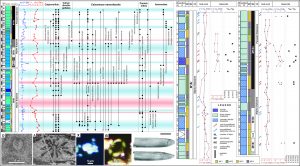 A unique exposure of the Štramberk Limestone in the Kotouč quarry was investigated by multidisciplinary approaches to clarify the age and paleoenvironmental conditions. Integrated stratigraphy (magnetostratigraphy, 87Sr/86Sr isotopes from belemnites, δ18O and δ13C stable isotopes from bulk rock, microfossil and ammonite assemblages) revealed an early Berriasian age and refused the presence of the Jurassic/Cretaceous boundary interval. The δ18O isotope signal from bulk rock together with microfossils distribution (calpionellids, calcareous nannofossils) show temperature oscillations throughout the studied successions. Boreal influences were detected by ammonites, supporting also climatic variations within the earliest Cretaceous. The limestone microfacies then revealed that all parts of a carbonate reef have been preserved in the quarry: slope, platform margin reefs, sand shoals, and possibly also patch-reefs in the inner platform.
A unique exposure of the Štramberk Limestone in the Kotouč quarry was investigated by multidisciplinary approaches to clarify the age and paleoenvironmental conditions. Integrated stratigraphy (magnetostratigraphy, 87Sr/86Sr isotopes from belemnites, δ18O and δ13C stable isotopes from bulk rock, microfossil and ammonite assemblages) revealed an early Berriasian age and refused the presence of the Jurassic/Cretaceous boundary interval. The δ18O isotope signal from bulk rock together with microfossils distribution (calpionellids, calcareous nannofossils) show temperature oscillations throughout the studied successions. Boreal influences were detected by ammonites, supporting also climatic variations within the earliest Cretaceous. The limestone microfacies then revealed that all parts of a carbonate reef have been preserved in the quarry: slope, platform margin reefs, sand shoals, and possibly also patch-reefs in the inner platform.
Vaňková L., Elbra T., Pruner P., Vašíček Z., Skupien P., Reháková D., Schnabl P., Košťák M., Švábenická L., Svobodová A., Bubík M., Mazuch M., Čížková K., Kdýr Š. (2019): Integrated stratigraphy and palaeoenvironment of the Berriasian peri-reefal limestones at Štramberk (Outer Western Carpathians, Czech Republic). Palaeogeography, Palaeoclimatology, Palaeoecology 532, 109256. (DOI)








